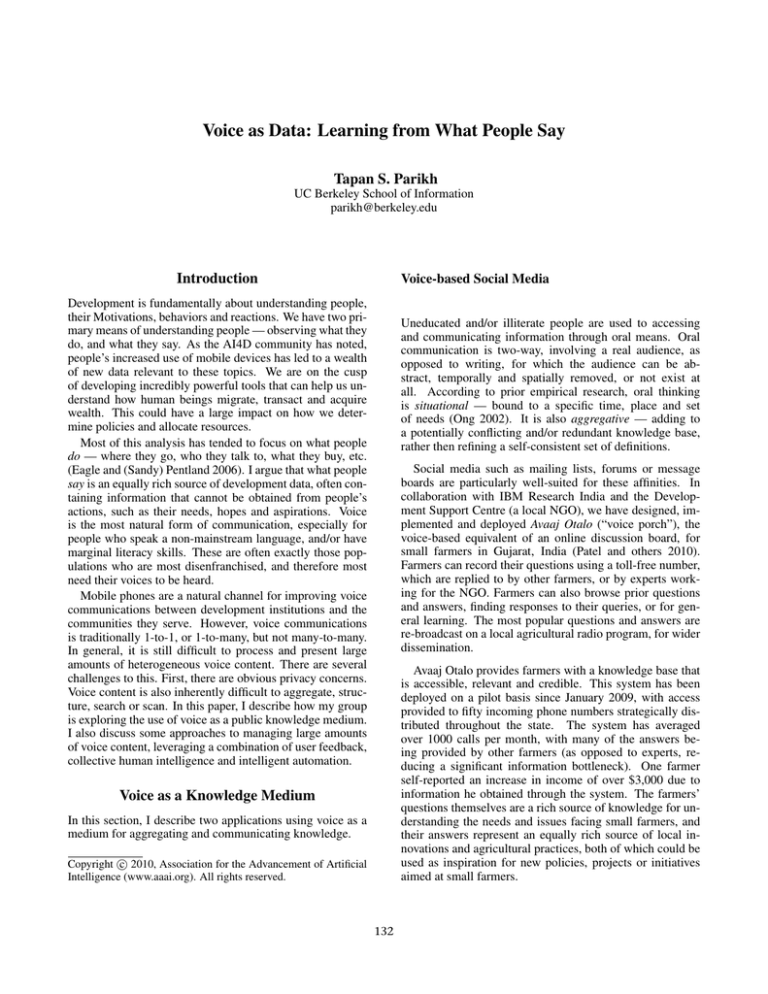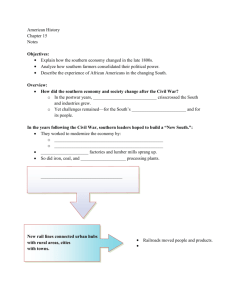
Voice as Data: Learning from What People Say
Tapan S. Parikh
UC Berkeley School of Information
parikh@berkeley.edu
Introduction
Voice-based Social Media
Development is fundamentally about understanding people,
their Motivations, behaviors and reactions. We have two primary means of understanding people — observing what they
do, and what they say. As the AI4D community has noted,
people’s increased use of mobile devices has led to a wealth
of new data relevant to these topics. We are on the cusp
of developing incredibly powerful tools that can help us understand how human beings migrate, transact and acquire
wealth. This could have a large impact on how we determine policies and allocate resources.
Most of this analysis has tended to focus on what people
do — where they go, who they talk to, what they buy, etc.
(Eagle and (Sandy) Pentland 2006). I argue that what people
say is an equally rich source of development data, often containing information that cannot be obtained from people’s
actions, such as their needs, hopes and aspirations. Voice
is the most natural form of communication, especially for
people who speak a non-mainstream language, and/or have
marginal literacy skills. These are often exactly those populations who are most disenfranchised, and therefore most
need their voices to be heard.
Mobile phones are a natural channel for improving voice
communications between development institutions and the
communities they serve. However, voice communications
is traditionally 1-to-1, or 1-to-many, but not many-to-many.
In general, it is still difficult to process and present large
amounts of heterogeneous voice content. There are several
challenges to this. First, there are obvious privacy concerns.
Voice content is also inherently difficult to aggregate, structure, search or scan. In this paper, I describe how my group
is exploring the use of voice as a public knowledge medium.
I also discuss some approaches to managing large amounts
of voice content, leveraging a combination of user feedback,
collective human intelligence and intelligent automation.
Uneducated and/or illiterate people are used to accessing
and communicating information through oral means. Oral
communication is two-way, involving a real audience, as
opposed to writing, for which the audience can be abstract, temporally and spatially removed, or not exist at
all. According to prior empirical research, oral thinking
is situational — bound to a specific time, place and set
of needs (Ong 2002). It is also aggregative — adding to
a potentially conflicting and/or redundant knowledge base,
rather then refining a self-consistent set of definitions.
Social media such as mailing lists, forums or message
boards are particularly well-suited for these affinities. In
collaboration with IBM Research India and the Development Support Centre (a local NGO), we have designed, implemented and deployed Avaaj Otalo (“voice porch”), the
voice-based equivalent of an online discussion board, for
small farmers in Gujarat, India (Patel and others 2010).
Farmers can record their questions using a toll-free number,
which are replied to by other farmers, or by experts working for the NGO. Farmers can also browse prior questions
and answers, finding responses to their queries, or for general learning. The most popular questions and answers are
re-broadcast on a local agricultural radio program, for wider
dissemination.
Avaaj Otalo provides farmers with a knowledge base that
is accessible, relevant and credible. This system has been
deployed on a pilot basis since January 2009, with access
provided to fifty incoming phone numbers strategically distributed throughout the state. The system has averaged
over 1000 calls per month, with many of the answers being provided by other farmers (as opposed to experts, reducing a significant information bottleneck). One farmer
self-reported an increase in income of over $3,000 due to
information he obtained through the system. The farmers’
questions themselves are a rich source of knowledge for understanding the needs and issues facing small farmers, and
their answers represent an equally rich source of local innovations and agricultural practices, both of which could be
used as inspiration for new policies, projects or initiatives
aimed at small farmers.
Voice as a Knowledge Medium
In this section, I describe two applications using voice as a
medium for aggregating and communicating knowledge.
c 2010, Association for the Advancement of Artificial
Copyright Intelligence (www.aaai.org). All rights reserved.
132
Voice-based Data Collection
can explicitly crowd-source tags for voice content, either by
users as part of the applications themselves, or using games,
micro-payments and other incentives. Finally, we can leverage feedback from users (for example, “click-through” rates,
or the equivalent), to improve the ranking of popular results.
Collecting accurate and timely information from rural communities is important for many purposes — including monitoring projects, conducting clinical trials, responding to
emergencies, maintaining medical records, managing supply chains, providing financial services, doing epidemiological surveillance and for conducting a survey or census.
Many groups are investigating the use of mobile phones for
collecting data. A recent study has shown that collecting
data using voice can significantly reduce errors, when compared to using interactive forms or composing a structured
text message (Patnaik and others 2009).
(Patnaik and others 2009) relied on a call center approach, where respondents called dedicated staff who asked
them questions and confirmed and recorded responses. This
incurs significant overhead in terms of phone airtime and
centralized office infrastructure and human resources. One
alternative that we are investigating is to allow field staff to
capture audio transcripts of their field interviews, which can
later be annotated and/or transcribed by trained data entry
staff in batch mode. Separating data collection from entry
could reduce airtime usage (because data could be transferred asynchronously), and allow for less staff to handle
the actual entry in batch mode.
Audio is also an effective medium for self-reporting, particularly of sensitive data. Audio computer-assisted selfinterviewing, or its telephonic variant, T-ACASI, is used
by psychologists, clinicians, social scientists and development practitioners as a cheap and private way of collecting
private, anonymous information from subjects (Cooley and
others 2000). Deploying such systems, accessible to remote
populations using a low-cost mobile phone, could drastically
reduce the costs and hence increase the reach of data collection. Timely and accurate responses would no longer depend
on a trained fieldworker being present at exactly the right
time and place.
Speech Recognition
Collecting speech training data is tedious, expensive and
labor-intensive (van Rooyen et al. 2008). Voice-based
knowledge systems, such as those described earlier, can generate a wealth of audio data for training purposes. This data
must be annotated and/or transcribed before it can be used
for training a speech recognizer or other natural language
system. We can leverage increased access to mobile phones,
and a distributed network of native speakers, to address this
problem. An automated system could call and replay important terms to users who could transcribe them using a reply
SMS message, or just repeat them over the phone (in the
process, generating additional pronunciations) (Ledlie and
others ). Repeating utterances could also be a form of voice
CAPTCHA that a user must perform before using an application or service. By generating transcriptions from multiple sources, and potentially for multiple versions of the utterance, we can aim for maximum coverage. Because the
transcription task is verifiable, it is more likely to generate
correct responses. We can also tie incentives to matching
consensus transcriptions. Payments can be issued in terms
of airtime, further reducing transaction costs. Transcription
can also done as an educational activity for students, for example for learning the English alphabet.
Conclusion
Making voice a first-class data type could dramatically increase public participation in knowledge creation. I have
described two applications and related technologies that explore this idea, and could make locally generated voice content more amenable to large-scale access and analysis.
Challenges and Opportunities
References
In this section, I outline two challenges to (and consequent
opportunities for) improving the functionality and usability
of voice knowledge systems.
Cooley, P. C., et al. 2000. Automating telephone surveys: Using
T-ACASI to obtain data on sensitive topics. Computers in Human
Behavior 16(1):1 – 11.
Eagle, N., and (Sandy) Pentland, A. 2006. Reality mining:
sensing complex social systems. Personal Ubiquitous Comput.
10(4):255–268.
Ledlie, J., et al. 2009. Crowd translator: On building localized
speech recognizers through micropayments. In NSDR 2009.
Ong, W. J. 2002. Orality and Literacy: The Technologizing of the
Word. Routledge.
Patel, N., et al. 2010. Avaaj Otalo — A field study of an interactive voice forum for small farmers in rural India. In CHI 2010.
Patnaik, S., et al. 2009. Evaluating the accuracy of data collection
on mobile phones: A study of forms, SMS, and voice. In ICTD
2009.
van Rooyen et al., M. 2008. The systematic collection of speech
corpora for all eleven official South African languages. In SLTU
2008.
Voice Search
Avaaj Otalo offers very limited navigation features. Farmers (and experts) must listen to all previous questions and
answers before they can find those relevant to them. Even
a rudimentary interface for tagging and/or searching could
dramatically improve the efficiency of this system. Indexing and search of complete voice transcripts is likely to be
infeasible for low-resource languages, at least with current
speech recognition technologies (see below). We are exploring several alternative ways to address this. First, as
search is already a “noisy”, potentially error-prone task, we
can use relatively low-grade speech recognition for clustering and/or categorizing highly related content. Second,
we can use contextual factors obtained from users (including location, language, dialect and inferred social and economic characteristics) to further group content. Third, we
133







